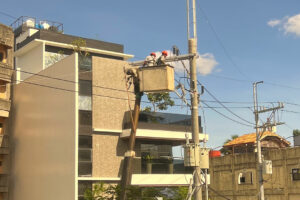THE Department of Energy (DoE) said it will review its target of achieving total electrification by 2028 amid concerns about the availability of funding.
“Since the President is approaching the middle of his term, it is a good time to review how realistic our targets and the funding available are and whether we can think of ways to hasten or to make them more realistic,” Energy Secretary Raphael P.M. Lotilla told reporters on the sidelines of an event on Wednesday.
Mr. Lotilla said that the DoE will discuss the total electrification program and the challenges in meeting the target during the next cabinet sector meeting with President Ferdinand R. Marcos, Jr.
The 2023-2032 National Total Electrification Roadmap (NTER) sets a 100% electrification target by 2028 by focusing on household electrification, distribution line extension, stand-alone home systems, and microgrid systems.
However, Mr. Lotilla said the Philippines will need at least P85 billion to P100 billion in order to achieve the electrification goal at the household level.
The estimated amount is intended not only to finance the household electrification, but also to improve backbone lines, especially in off-grid areas, Mr. Lotilla said.
NTER estimates the current household electrification level at 91.1% as of June 2023, with 25.3 million households served out of a potential 27.727 million, based on the 2020 Census on Population and Housing.
For the rest of 2023, the estimated number of underserved households total 2.454 million.
“If the funds are available, it would take an average of around P25 billion a year to finish electrification,” Mr. Lotilla said. “Congress appropriates on a yearly basis so we don’t know if there will be sufficient funds.”
Energy Undersecretary Rowena Cristina L. Guevara has said that about P100 billion is needed for total electrification, with P75 billion going to the electric cooperatives supervised by the National Electrification Administration and about P25 billion to the National Power Corp.
“As of the midpoint of the administration, the average budget has only been between P2 billion to P3 billion a year and therefore we have a long way to go before we can achieve that goal. So we are looking at ways and means to achieve the total electrification goal,” Mr. Lotilla said.
The DoE is also preparing to ensure energy resiliency during the upcoming mid-term elections.
With the official campaign period set to begin next week, the department has activated Task Force Election to ensure uninterrupted power for the campaign period and voting.
The DoE said it is working with the Commission on Elections and the Department of National Defense to safeguard the integrity and smooth conduct of the elections “through strategic energy sector preparedness before, during, and after the electoral process.”
“Ensuring uninterrupted power during elections is crucial to upholding the integrity of the electoral process and maintaining public confidence. By prioritizing energy resiliency, Task Force Election plays a vital role in guaranteeing smooth and credible elections, free from power-related disruptions,” Energy Undersecretary Felix William B. Fuentebella said.
The DoE said that the task force will remain on standby throughout the election period at a command hub to monitor and address potential power issues in real time.
The DoE is also collaborating with the Department of Interior and Local Government to ensure the availability of critical backup resources, including generator sets and emergency lamps at key locations.
The DoE added that it will release the terms of reference this month for the fourth round of the green energy auction program (GEA-4), which will cover integrated renewable energy and energy storage systems.
The Terms of Reference outlines the auction design, bond requirements, instructions to bidders, bidding data, forms and templates, and post-auction requirements.
The draft GEA-4 terms of reference will be subject to public consultations.
The government hopes to expand the share of renewable energy capacity in the energy mix to 35% by 2030. — Sheldeen Joy Talavera
